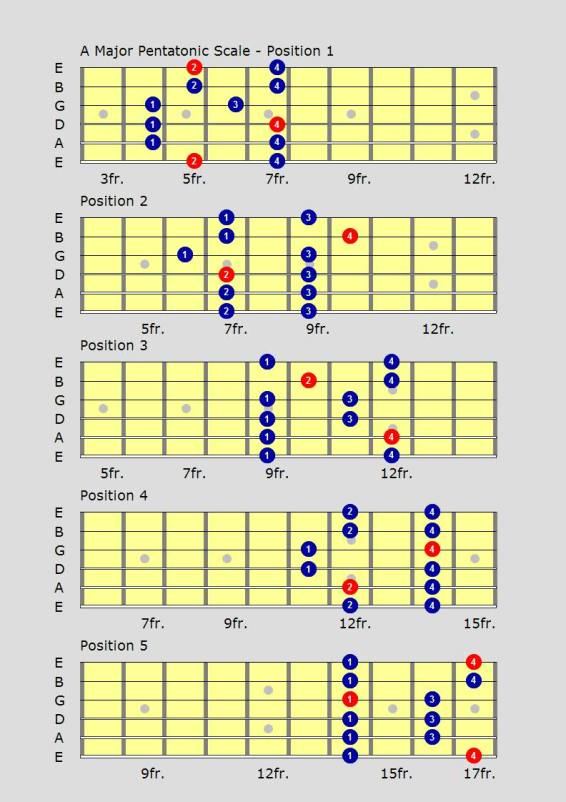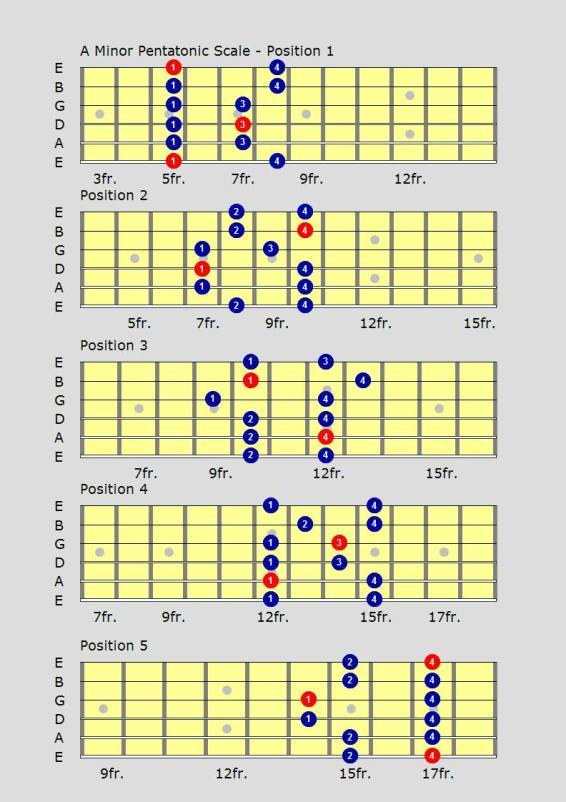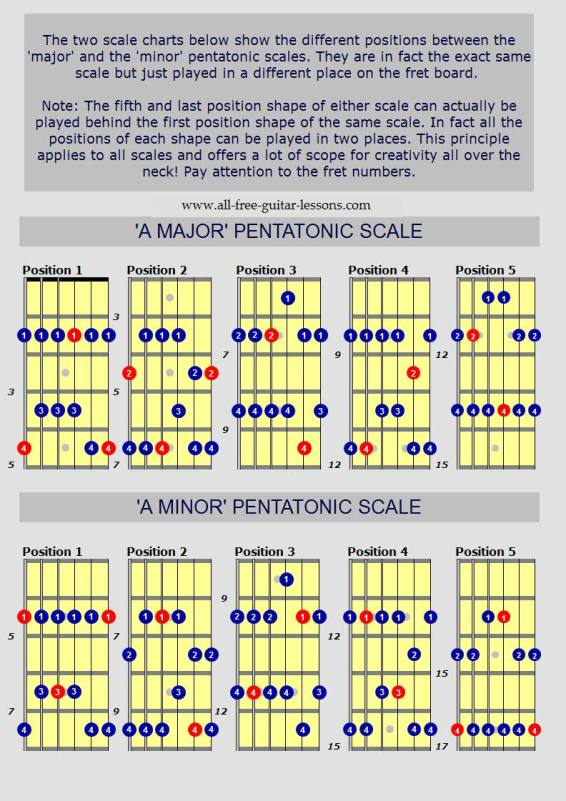Pentatonic Guitar Scales
The following pentatonic guitar scales are in the key of 'A'. Therefore the first pentatonic scale position starts on A at the fifth fret. The video at the bottom of this page is in 'G', so, all you need to do is move all the charts down two frets from 'A' to 'G' so they correspond with the video.
Alternatively, and probably far better, is too take a look at the blues guitar scales which include pentatonic scales charts and happen to be in the key of G and therefore do correspond with the video further down. Sorry for any confusion. I will be making this clearer in the coming weeks/new year.
Website Owners & Bloggers
Feel free to copy and use any charts on this site. Please show your appreciation for all my time and hard work spent creating them by leaving the URL of this site on those charts that have it and please create a link back here. Thank you.
A pentatonic scale is a 5 note scale. Any scale that contains 5 notes is theoretically a pentatonic scale, just like a pentagon has five sides. When we say 'five notes' we don't mean that five single notes are only played. What we mean is five musical notes are played before the octave is reached and it all starts again.
There are two commonly known and played pentatonic scales, the major pentatonic scale and the minor pentatonic scale respectively.
These two pentatonic scales are used in more musical styles than many of us possibly know. They are played in rock, country, blues, Gospel, jazz, jazz funk, fusion, and pop music too. What's more is the fact that they're also played in other cultures' musical styles including; Celtic folk music, Hungarian folk music, West African music, Greek music as well as the music of Korea, Thailand, Malaysia, Japan, China, Vietnam and many more. Wow!
Why Pentatonic Scales?
Pentatonic scales consist of two notes to a string making them relatively easy scales to play in comparison with some of the other guitar scales to be learned. The major and minor pentatonic guitar scales are great first scales to learn and to get under your belt due to their relative ease of playing and great versatility. They are also extremely forgiving scales because you can almost hit any of the notes within the scale and it will sound pretty good over any relative chord or chord progression.
The pentatonic guitar scales are also great for techniques like hammer-ons and pull-offs which are used a lot in blues, rock, and country guitar styles which these two scales are used for pretty much most of the time.
The Major Pentatonic Guitar Scale
The major pentatonic scale is a five note scale that consists of the 1st, 2nd, 3rd, 5th and 6th notes of the major scale.
As the name suggests, the major pentatonic is played over major chords such as basic major triad (three note) chords as well as major 7 (maj7), and Dominant 7 (dom7) chords such as played in blues, modern types of jazz/fusion, rock, country and any styles with these chord types and progressions consisting of the same types of chords.
The Minor Pentatonic Guitar Scale
Basically speaking, the minor pentatonic scale is the major pentatonic scale played in a different place on the fret board. In a sense, the minor pentatonic is the exact same scale as the major pentatonic as far as the fingering patterns are concerned and given the fact that it too consists of five notes.
From a music theory point of view, the difference is that the minor pentatonic consists of the 1st, 3rd, 4th, 5th and 7th notes of the natural minor scale or the 1st, b3rd, 4th, 5th and b7th notes of the major scale.
The minor pentatonic scale is minor in its structure and is therefore played over minor, minor sevenths and dominant seventh chords.
The minor pentatonic scale is played three frets up from its relative major pentatonic cousin. Meaning, any major pentatonic scale fingering pattern becomes a minor pentatonic fingering pattern when played three frets higher up the neck towards the bridge.
The minor pentatonic is probably played more in popular Western music than any other scale as well as blues, rock, heavy metal, jazz and fusion.
Major & Minor Pentatonic Differences
The difference between the major pentatonic and the minor pentatonic guitar scales is often a little confusing. First of all they start at a different place on the fret board from each other. Secondly, their root note starts in a different place within the scale. This ultimately gives them a different step-pattern from one another and therefore a different sound.
What is often confusing and misunderstood though is that this different sound is only noticeable when both scales are played against the same chord or chord progression. When played alone without chords though, the major and minor pentatonic scales ultimately appear to be the same scale and therefore sound the same. But remember, when played correctly by starting them on their individual root note this is not the case. As we have already determined, this different root note position within the scale creates a different step-pattern and a different sound. See the pentatonic comparison chart at the bottom of the page.
The Five Pentatonic Guitar Scale Positions
Like all guitar scales, there is more than one place or position on the guitar neck that you can play the pentatonic scales. If you only want to learn and play the most commonly used first position of the minor pentatonic for example, that's fine, but you'll definitely be limiting yourself if you do.
If you really want to make a big difference to your guitar playing, whatever style of music you're interested in, it's essential that you learn all five positions of the pentatonic guitar scales throughout the entire neck. This will give you a greater command of the fret board which in turn will allow you to express yourself more whilst playing your rock, blues, country and jazz guitar solos.
Learn all five Positions
Take a look at the second video down on the blues guitar scales page of me playing the blues guitar scale which is essentially the pentatonic scale with the "blue note" added. The importance of learning all five positions is relevant here I think.
By learning all five positions of each of the major and minor pentatonic guitar scales you will easily be able to change the direction of your blues guitar solo along with the changes that take place within the blues guitar chords progression or other chord progression that you'll be playing your solo over. This makes for a much more interesting and fruitful solo rather than staying in just one or two positions throughout.
Once you can play the pentatonic guitar scales reasonably well, you'll be able to play along to many different songs including; rock, pop, rockabilly, bluegrass, Jazz, Jazz blues, jazz fusion and mainstream blues tracks too of course.
The following pentatonic scales are in the key of A just to keep things nice and simple and not have to play 'open' strings. The root notes in red are therefore the note of A. The notes are not included and have been replaced with the number of the appropriate finger to use for each note. Please see the key below.
1 = index finger, 2 = middle finger, 3 = ring finger,
4 = little (pinkie) finger.
The Major Pentatonic Scale - Two Different First Positions?
When learning and practicing the MAJOR pentatonic guitar scales, one thing to consider is that there are seemingly two schools of thought regarding the first position of the major pentatonic scale.
The most recognised and followed first position, I think, for the major pentatonic scale - probably for ease of remembering - is what is shown in the first major pentatonic scale chart shown below. It's the exact same fingering pattern as the first position fingering pattern of the minor pentatonic scale but played three frets down towards the nut and head of the guitar.
I think this method may offer an easier way for some to remember which is why it tends to be the most recognised possibly and why I have included it first in the major pentatonic guitar scales chart.
The Second Approach to Position 1 - Preferred
The second, and my preferred first position to the major pentatonic scale, is that shown in the second major pentatonic scale chart further down. This fingering pattern is the same pattern as the second fingering pattern of the minor pentatonic scale but played where the first position of the minor pentatonic would be played. So you would just start the Major pentatonic scale at the same place you would start the Minor pentatonic scale but you would use the second position fingering pattern of the Minor pentatonic guitar scale.
Personally, I prefer this approach because it makes it more simple to play straight after playing the first dominant 7 chord (I chord) of the blues chord progression you will be playing, as the fingers are already in position at that fret and in contact with the notes when holding down that I chord. It therefore pulls out certain key notes of that I chord of the progression which all in all makes it sound so much better to me.
By playing the major pentatonic first position this way, and therefore playing some of the notes of the I chord, you are actually playing an arpeggio which is nothing more than notes of a chord played singularly as opposed to being strummed.
It's best to go with what feels the most comfortable to you though, and let's not forget that all scales, including both the major and minor pentatonic guitar scales, effectively become one complete scale when all the positions link up.
Add to this, the fact that each position of the same scale, major or minor, has the same notes, and technically it doesn't really matter that much what you choose to use as the first major pentatonic position. It comes down to what is easiest for you to relate to and able apply to the fret board.
Having said that, certain positions and individual notes do sound better than others at certain times (obviously!) during the chord progression that you'll play over. This will become clearer as you progress at playing the scales and more aware of the changes that are taking place within the blues chord progression. After a while you will start to develop your own style and go where you feel.
The word 'feel' is very important to me. I think it's important to learn what you need to as far as the theory is concerned, but music is ultimately about feeling, just as long as you have enough theoretical knowledge and understanding to put that feeling into practice.
The art of Soloing
Ultimately, we are trying to take the solo somewhere. We are trying to make it say something and to give the listener something to hang their ear upon so to speak. If we can create chord changes without actually playing chords - so we can here where the chord changes would be, just by playing a solo - then we are going in the right direction I think.
I try to do this at the beginning of the G minor blues scale video which is the second video on the Blues Guitar Scales page which I mentioned earlier on this page above. I try to take the solo where I think the chords would be changing. It's much easier to do at a slower tempo and also with a backing track which I never had in this video which is why I made quite a few little mistakes. I could have done it again in another take but though it would in some way be educational to leave it as I first played it. to show that you should just carry on and keep playing to try to find something.
I carried on and kept the rhythm and beat going. This is very important because you then start to get into the groove and it's a far more positive approach than to keep stopping. Feel the beat and the rhythm and try to create something. Of course this is not what you should do if you're just starting out with the pentatonic guitar scales. This approach is only when you're a bit more fluent with them.
Remember, all scale positions effectively become one complete scale when all the positions link up. Once you become fluent with all of them by fluently moving from one position to another and all the way through all the positions, you'll unlock the entire fret board and progress to playing interesting and fruitful solos whether you play rock, blues, jazz or pop.
Enjoy what you do
The most important thing really though, is that we enjoy what we are doing and have fun with it. Don't get bogged down and become negative if we aren't having any great success. I make lots of mistakes as can be seen in my videos. I do hit bum notes and play out of time a fair bit I would say. None of that matters though, not really, unless you're on stage and making mistakes all the time, then it's a problem.
You can only do what you can do at any one given time. Just do your best and enjoy what you do. Making mistakes is all part of learning the guitar and should be your drive to practice more rather than a reason to give up.
Essentially, the five positions all connect and blend together to essentially form one entire scale.
A Major Pentatonic Scale
Pentatonic Guitar Scales Chart #1
Musical Styles - Country, Blues, Rock, Fusion, Jazz
Chords Played Over - Major, Major Sevenths, Dominant Sevenths.
Major Scale Comparison - Root-2-3-5-6-Octave
Intervals - T,T,T+S,T,T+S
T = Tone (whole step/2 frets), S = Semi-tone (half step/1 fret)
Stick to the fingering patterns shown in all the charts, at least when learning. It will benefit you massively in the long-run. Don't be lazy and try to cut corners just because it seems easier by sliding up and down with the same fingers. You'll limit yourself in the long run by doing this.
This is great exercise for technique, hand strength and dexterity.
index finger=1, middle finger=2, third (ring) finger=3 and little (pinkie) finger=4.
First approach to position 1

'A' Major Pentatonic Scale
Pentatonic Guitar Scales Chart #2
Second approach to position 1

A Minor Pentatonic Scale
Pentatonic Guitar Scales Chart #3
Musical Styles - Blues, Rock, Fusion, Heavy Metal, Jazz
Chords Played Over - Minor, Minor Sevenths,
Dominant Sevenths.
Major Scale Comparison - Root-b3-4-5-b7-Octave
Intervals - T+S,T,T,T+S,T
T = Tone (whole step/2 frets), S = Semi-tone (half step/1 fret)

This video shows the minor pentatonic guitar scale in 'G' starting on the third fret. Just move all the charts down 2 frets to correspond with this video.
Back To TopA Major & A Minor
Pentatonic Guitar Scales Compared
Pentatonic Guitar Scales Chart #4
The following chart compares the different positions of the major and minor pentatonic guitar scales. It's based upon the first approach to position 1 for the Major Pentatonic Scale as this shows a much clearer comparison by using the same finger patterns as the minor pentatonic.
Remember to follow the numbers of the finger positions for the correct way to play. This teaches greater technique, finger strength, flexibility and dexterity. This strict attention to the finger numbers will pay off massively in the long-run.
You can use other fingers when you're more accomplished.
index finger=1, middle finger=2, third (ring) finger=3 and little (pinkie) finger=4.

I hope you found these charts and accompanying video for the important pentatonic guitar scales helpful and of value to your playing. Please return to this site as I will continue to add more instructional videos for both the major and the minor pentatonic guitar scales over time.
Please help to grow this site by clicking the pay it forward link at the bottom of the page and/or by sharing it on your favourite social site. Many thanks.
Keep up the practice!
Back To Top
Guitar Scales Chart | Blues Guitar Scales
Jazz Guitar Scales | Guitar Chords Chart | Blues Guitar Chords
Major Guitar Scale | Guitar Lessons for Beginners | Home
